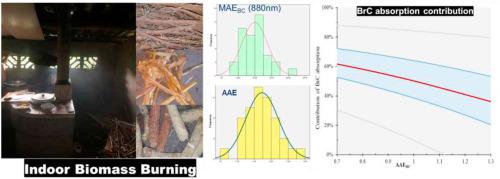Environmental Pollution ( IF 8.9 ) Pub Date : 2020-09-18 , DOI: 10.1016/j.envpol.2020.115652 Lu Zhang , Zhihan Luo , Wei Du , Gang Li , Guofeng Shen , Hefa Cheng , Shu Tao

|
The optical properties of light-absorbing carbonaceous aerosols have caused increasing concerns due to their significant impacts on local and regional climates. In this study, particles from biomass burning in home stoves were collected and evaluated for their optical properties. The absorption Ångström exponent (AAE) values ranged from 1.17 to 2.92 and were negatively correlated with the modified combustion efficiency, suggesting more brown carbon in combustion emissions with relatively low combustion efficiencies. The average contribution of brown carbon to the total aerosol absorption at 370 nm was equally as important as that of black carbon (BC), with the average relative contribution fraction of 50% varying from 10% to 84% for different biomasses. The average value of the mass absorption efficiency (MAE) of BC (MAEBC) at 880 nm was positively correlated with the ratio of organic carbon to elemental carbon, indicating the significant coating effects of organic aerosols. The MAE values of BrC at 370 nm were in the range of 1.1-11.3 m2/g, with an average of 5.1±2.2 m2/g. The estimated absorption emission factors at 370 nm and 880 nm were 3.75±3.45 and 0.84±0.78 m2/kg, respectively. These results are valuable for a better understanding of the optical properties of particles emitted from real-world biomass burning, and the field-based data are useful in future modeling studies of biomass burning impacts on climate. However, the limitation of the relatively small sample size for each subgroup fuel calls for more field- and lab-based emission characterization research.
中文翻译:

室内生物质燃烧的光吸收特性和吸收发射因子
吸光性碳质气溶胶的光学性质由于对当地和区域气候的重大影响而引起了越来越多的关注。在这项研究中,收集了在家用炉灶中燃烧的生物质产生的颗粒,并对其光学特性进行了评估。吸收Ångström指数(AAE)值在1.17到2.92之间,并且与修改后的燃烧效率呈负相关,这表明燃烧排放物中的褐碳更多,而燃烧效率却相对较低。棕色碳在370 nm的总气溶胶吸收中的平均贡献与黑碳(BC)一样重要,不同生物质的平均相对贡献分数为50%,从10%到84%不等。的质量吸收效率的平均值的BC(MAE)(MAE BC)在880 nm处与有机碳与元素碳的比例呈正相关,表明有机气溶胶具有显着的涂层作用。BrC在370nm处的MAE值在1.1-11.3m 2 / g的范围内,平均为5.1±2.2m 2 / g。在370 nm和880 nm处估计的吸收发射因子分别为3.75±3.45和0.84±0.78 m 2 / kg 。这些结果对于更好地了解现实世界中生物质燃烧产生的颗粒的光学特性非常有价值,基于现场的数据对于生物质燃烧对气候影响的未来建模研究很有用。但是,每个子组燃料相对较小的样本量的限制要求进行更多基于现场和实验室的排放表征研究。



























 京公网安备 11010802027423号
京公网安备 11010802027423号